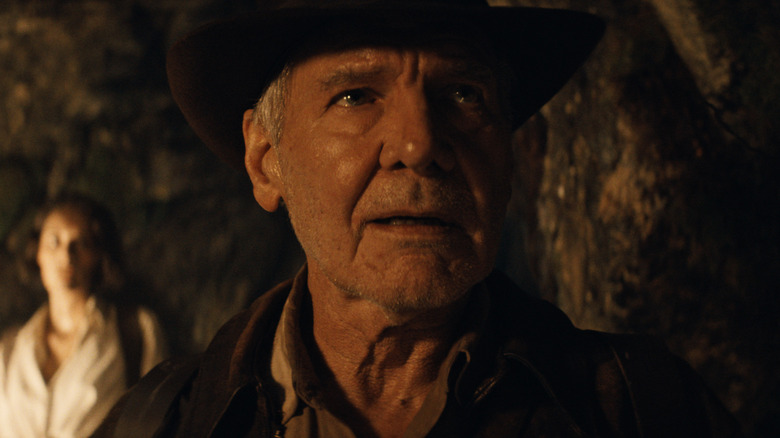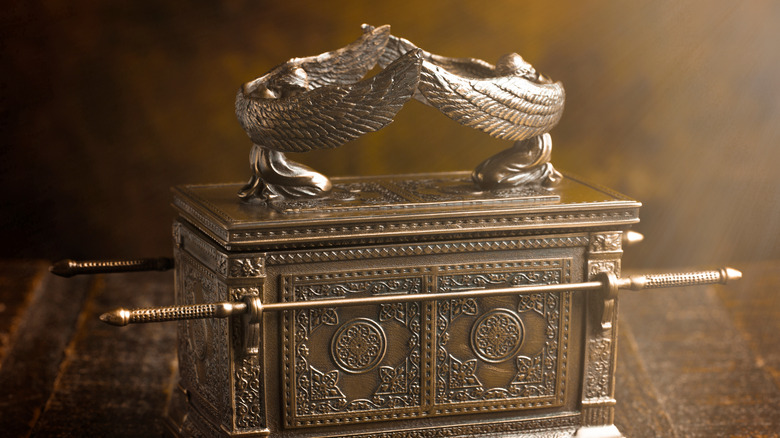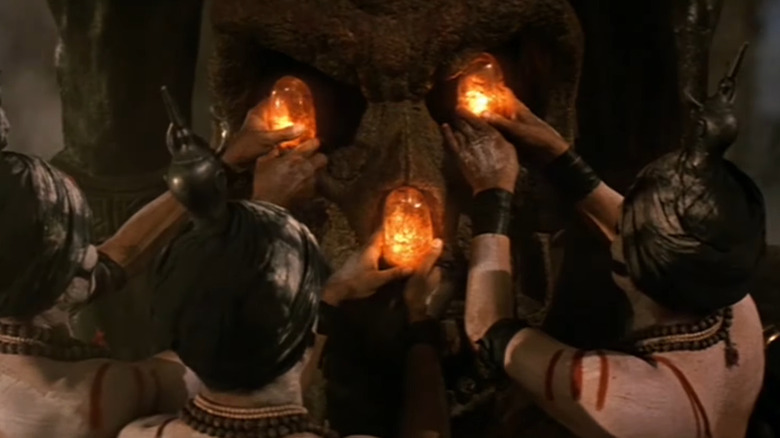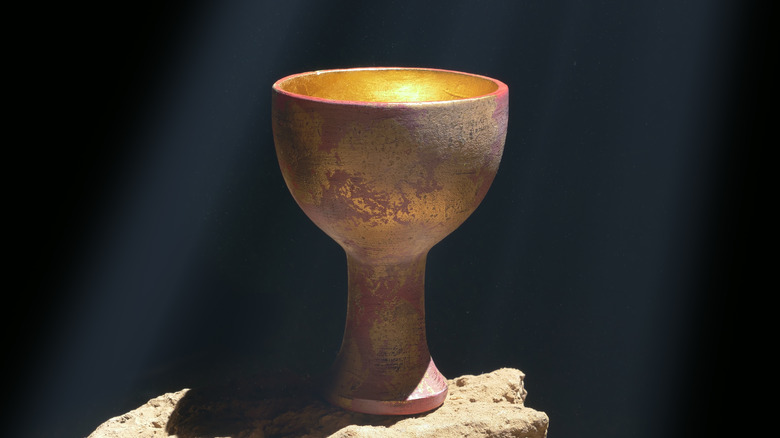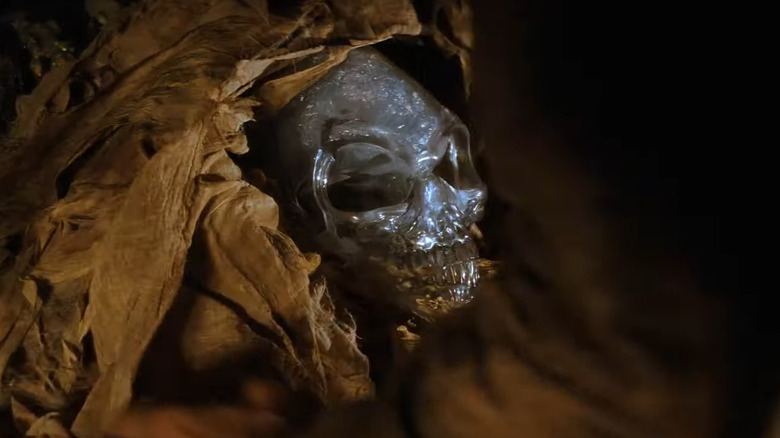Indiana Jones & The Dial Of Destiny - Is The Antikythera Real? History Explained
Warning: This article contains spoilers for "Indiana Jones and the Dial of Destiny."
The Dial of Destiny might be the most realistic MacGuffin in the "Indiana Jones" franchise yet.
The titular mechanism from Ancient Greece — also referred to in the film as the Antikythera, as well as the Archimedes Dial (for its supposed inventor) — is said to be able to predict the times, dates, and places of naturally occurring temporal anomalies that, when passed through, can transport a person back to certain points in the time stream. And we here at Looper are happy to report that, yes, the mechanism is real. And, yes: it's basically a Time Machine (our sources relay that "The Simpsons" writers have been hanging onto it for the past few decades).
Okay, in all seriousness, of course, there isn't actually a Hellenistic time travel map just floating around in pieces out there — but the object it's based on may be just as impressive. According to the Smithsonian Magazine, the Dial of Destiny is loosely based on a real, 2,000-year-old device called the Antikythera Mechanism, so named for the Grecian island it was traced to. Discovered by divers off the coast of said island at the turn of the 20th century, the mechanism is often described as the first working computer, capable of tracking planets and stars, charting cultural events such as the Olympics, and acting as a basic calendar.
Given how its invention could have arguably given its controllers (one of whom may have only theoretically been Archimedes) a novel mastery over the concept of time, it's easy to see how James Mangold and his collaborators reimagined it as a time travel device. As far-fetched as an extrapolation as it may be, it's arguably one of the more historically tangible "Indiana Jones" treasures so far.
The Ark of the Covenant has never been verified as real
The Antikythera mechanism is but the fifth semi-historical device to be married to legend in order to justify a raucous Harrison Ford adventure, its four predecessors having significantly shakier factual legs to stand on.
The first film, "Raiders of the Lost Ark," featured the biblical — and apparently dangerous — container known as the Ark of the Covenant, which is said to carry what remains of Moses' Ten Commandments. Whether or not such an artifact has ever existed has never been officially decided, though — adhering to writings in the Old Testament — it is theorized to have disappeared when the Israelites were conquered by the Babylonian Empire in 597 BCE, possibly destroyed or lost in the battle.
The Church of Our Mary, Lady of Zion in Ethiopia claims to have taken the sacred artifact into their care sometime after crown prince Menelik the First paid tribute to his father, King Solomon, in Israel, a claim which may slightly contradict more popular reconciliations between history and theology. Per the church's statements, the Ark remains in their care and has only been seen by one person. As such, its existence remains unverified and is largely presumed to be a biblical legend.
The Sankara Stones were the invention of American screenwriters
Fortunately, the MacGuffin of the second installment in the franchise, "Indiana Jones and the Temple of Doom," has a far simpler backstory. In the film, they are said to hold great power capable of bringing about global destruction if all five of their kind are united. Ostensibly, they were originally gifts from Hindu deities.
While there are certain Hindu stories and objects that bear resemblance to the lore presented by "Temple of Doom," the Sankara Stones are mostly an amalgamation of various Indian cultural concepts by which the film's two American screenwriters — Willard Huyck and Gloria Katz — were particularly fascinated. George Lucas reportedly settled on the stones as the central object of "Doom's" narrative, but not before consulting heavily with Huyck and Katz due to their apparent knowledge of Indian culture. However, given how poorly the film has aged in the many years since its release — even Steven Spielberg dislikes "Temple of Doom" — it's safe to say the film carries a whole lot of baggage in today's world.
The Holy Grail might not even be a cup at all
While "Monty Python and the Holy Grail" may be perhaps the film most synonymous with the mythical, supposedly Christian chalice (or bowl, or plate, or rock, depending on which legend you fancy), "Indiana Jones and the Last Crusade" is a close second. When Henry Jones Sr. (played by the late Sean Connery) disappears during his long and manic search for the artifact, Indiana Jones follows in his footsteps to save his father and stop the Nazis from unlocking the secrets of eternal life. Despite the film being a beloved entry in the series and, briefly, a satisfying finale for the entire franchise, Lucas was apparently so insecure about his choice of the Grail as a plot device for the third film that he developed the father-son adventure just to make up for what the artifact lacked.
It's entirely unknown if the Holy Grail existed or not, or even if it was actually tied to the Christian religion at all. It's primarily a literary MacGuffin that appeared in various poems and writings, most prominently in Arthurian legend. Whatever properties it may or may not have had, however, it certainly didn't possess the capability to grant those that consume its contents eternal life. That power was devised entirely by Lucas and director Steven Spielberg in order to give the Grail the same lightly supernatural mystique expected of the series' artifacts by that point.
The Crystal Skulls are, likely, a hoax
Though "Dial of Destiny" may be the poorest reviewed film in the franchise, there's little doubt that "Kingdom of the Crystal Skull" is the most infamous "Indiana Jones" film to date — particularly because of its baffling choice of subject.
According to the film, these Crystal Skulls — seemingly with loose ties to ancient Aztec culture — hold immense powers of telekinesis and the secrets of our place in the universe. In other words, they're alien artifacts.
Though the Crystal Skulls are obviously not psychically charged artifacts with ties to little grey interplanetary (or inter-dimensional) beings, they're not even believed to be real by mythological standards. At best, Crystal Skulls are artifacts of dubious cultural origin and historical significance — at worst, they were a hoax primarily orchestrated by European "archaeologists" to profit off of mystified (read: ignorant) popular assumptions about indigenous cultures.
Especially compared to this crystal calumniation, the Dial of Destiny is a pretty grounded choice of historical object for an "Indiana Jones" story, especially given that its inspiration has been recovered, replicated, and extensively studied by historians, scientists, and mathematicians across the world. For all its faults, this fifth and final film has one foot planted firmly in historical fact.
Or, at least very least, one toe.
